NISSAN LEAF 2023 Owner's Guide
Manufacturer: NISSAN, Model Year: 2023, Model line: LEAF, Model: NISSAN LEAF 2023Pages: 612, PDF Size: 7.42 MB
Page 31 of 612
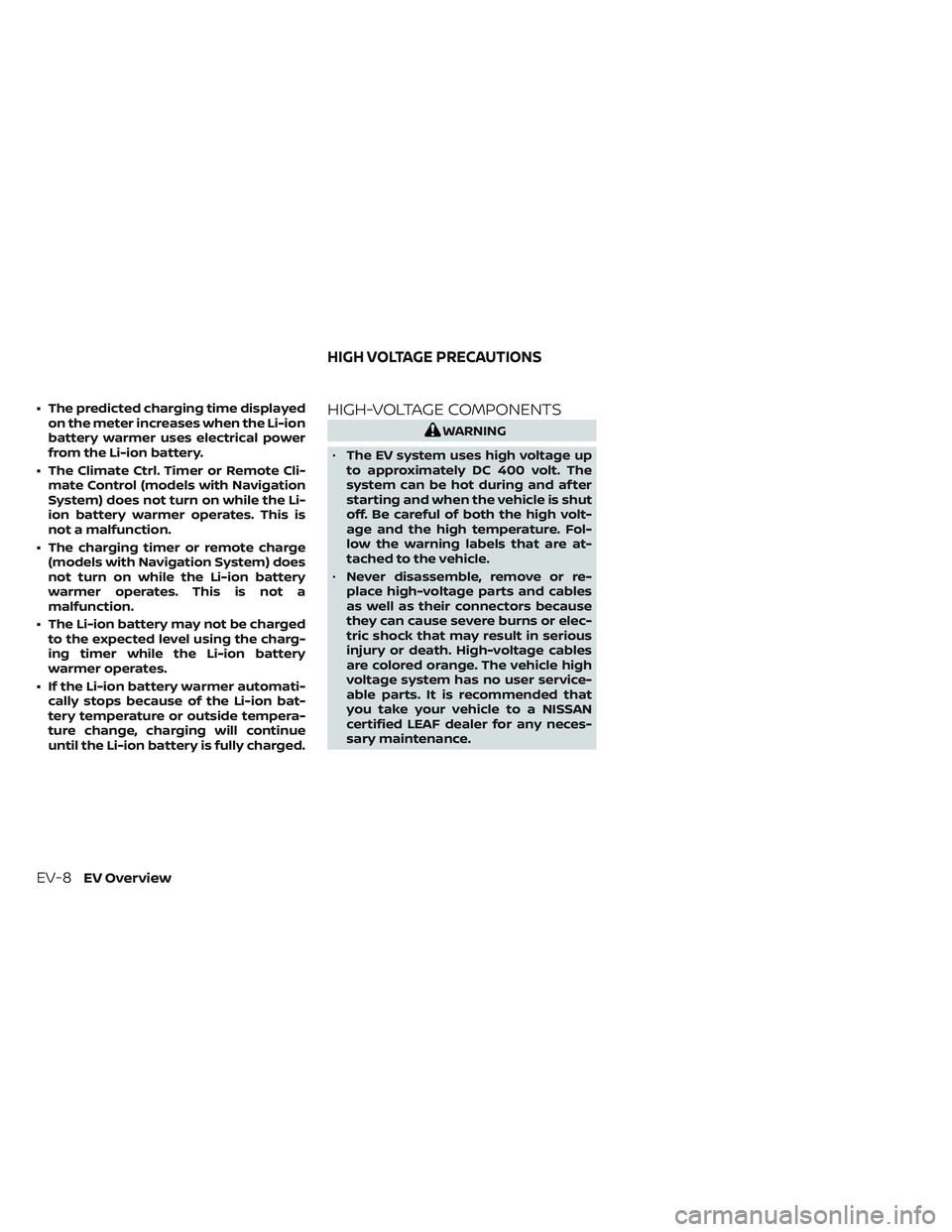
• The predicted charging time displayedon the meter increases when the Li-ion
battery warmer uses electrical power
from the Li-ion battery.
• The Climate Ctrl. Timer or Remote Cli- mate Control (models with Navigation
System) does not turn on while the Li-
ion battery warmer operates. This is
not a malfunction.
• The charging timer or remote charge (models with Navigation System) does
not turn on while the Li-ion battery
warmer operates. This is not a
malfunction.
• The Li-ion battery may not be charged to the expected level using the charg-
ing timer while the Li-ion battery
warmer operates.
• If the Li-ion battery warmer automati- cally stops because of the Li-ion bat-
tery temperature or outside tempera-
ture change, charging will continue
until the Li-ion battery is fully charged.HIGH-VOLTAGE COMPONENTS
WARNING
• The EV system uses high voltage up
to approximately DC 400 volt. The
system can be hot during and af ter
starting and when the vehicle is shut
off. Be careful of both the high volt-
age and the high temperature. Fol-
low the warning labels that are at-
tached to the vehicle.
• Never disassemble, remove or re-
place high-voltage parts and cables
as well as their connectors because
they can cause severe burns or elec-
tric shock that may result in serious
injury or death. High-voltage cables
are colored orange. The vehicle high
voltage system has no user service-
able parts. It is recommended that
you take your vehicle to a NISSAN
certified LEAF dealer for any neces-
sary maintenance.
HIGH VOLTAGE PRECAUTIONS
EV-8EV Overview
Page 32 of 612
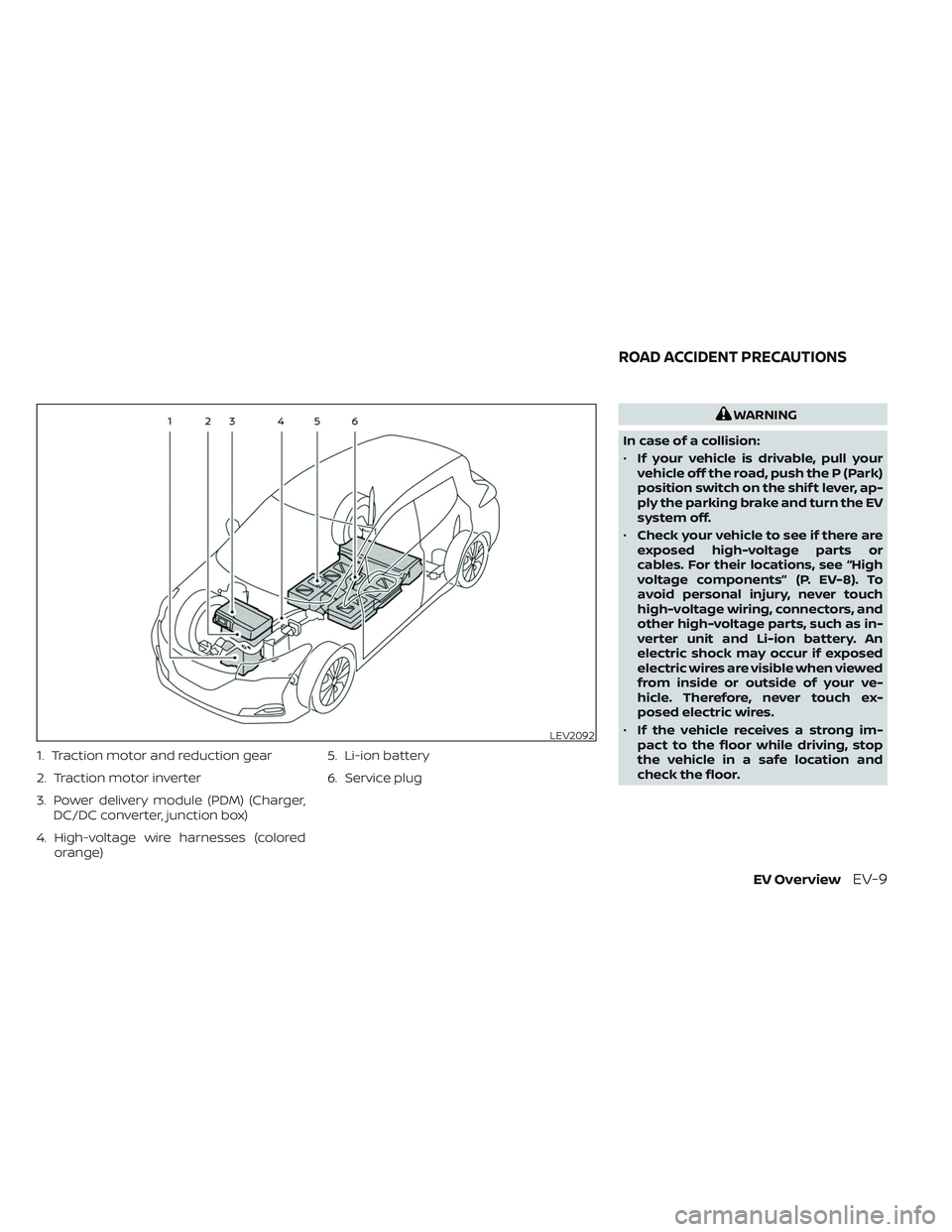
1. Traction motor and reduction gear
2. Traction motor inverter
3. Power delivery module (PDM) (Charger,DC/DC converter, junction box)
4. High-voltage wire harnesses (colored orange) 5. Li-ion battery
6. Service plug
WARNING
In case of a collision:
• If your vehicle is drivable, pull your
vehicle off the road, push the P (Park)
position switch on the shif t lever, ap-
ply the parking brake and turn the EV
system off.
• Check your vehicle to see if there are
exposed high-voltage parts or
cables. For their locations, see “High
voltage components” (P. EV-8). To
avoid personal injury, never touch
high-voltage wiring, connectors, and
other high-voltage parts, such as in-
verter unit and Li-ion battery. An
electric shock may occur if exposed
electric wires are visible when viewed
from inside or outside of your ve-
hicle. Therefore, never touch ex-
posed electric wires.
• If the vehicle receives a strong im-
pact to the floor while driving, stop
the vehicle in a safe location and
check the floor.
LEV2092
ROAD ACCIDENT PRECAUTIONS
EV OverviewEV-9
Page 33 of 612
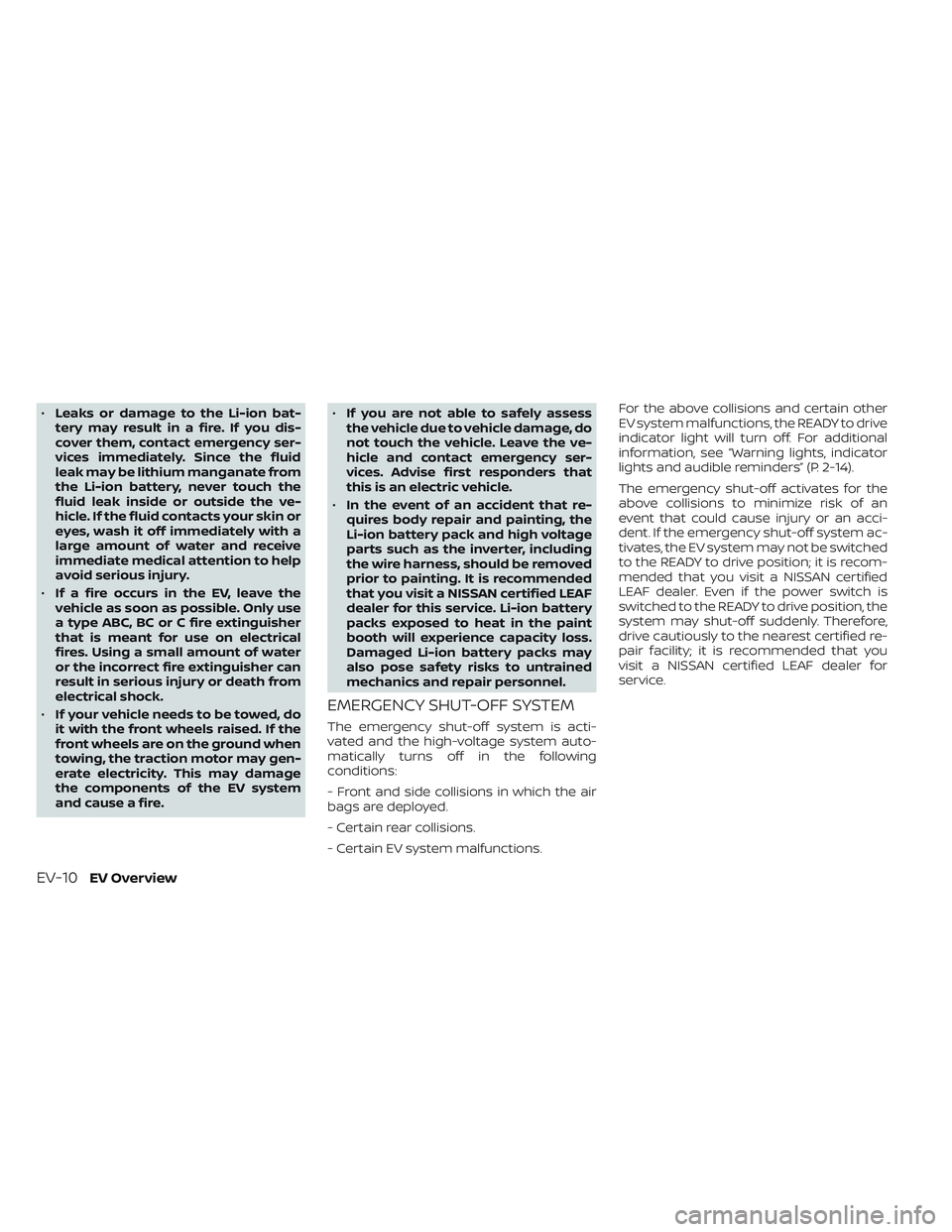
•Leaks or damage to the Li-ion bat-
tery may result in a fire. If you dis-
cover them, contact emergency ser-
vices immediately. Since the fluid
leak may be lithium manganate from
the Li-ion battery, never touch the
fluid leak inside or outside the ve-
hicle. If the fluid contacts your skin or
eyes, wash it off immediately with a
large amount of water and receive
immediate medical attention to help
avoid serious injury.
• If a fire occurs in the EV, leave the
vehicle as soon as possible. Only use
a type ABC, BC or C fire extinguisher
that is meant for use on electrical
fires. Using a small amount of water
or the incorrect fire extinguisher can
result in serious injury or death from
electrical shock.
• If your vehicle needs to be towed, do
it with the front wheels raised. If the
front wheels are on the ground when
towing, the traction motor may gen-
erate electricity. This may damage
the components of the EV system
and cause a fire. •
If you are not able to safely assess
the vehicle due to vehicle damage, do
not touch the vehicle. Leave the ve-
hicle and contact emergency ser-
vices. Advise first responders that
this is an electric vehicle.
• In the event of an accident that re-
quires body repair and painting, the
Li-ion battery pack and high voltage
parts such as the inverter, including
the wire harness, should be removed
prior to painting. It is recommended
that you visit a NISSAN certified LEAF
dealer for this service. Li-ion battery
packs exposed to heat in the paint
booth will experience capacity loss.
Damaged Li-ion battery packs may
also pose safety risks to untrained
mechanics and repair personnel.
EMERGENCY SHUT-OFF SYSTEM
The emergency shut-off system is acti-
vated and the high-voltage system auto-
matically turns off in the following
conditions:
- Front and side collisions in which the air
bags are deployed.
- Certain rear collisions.
- Certain EV system malfunctions. For the above collisions and certain other
EV system malfunctions, the READY to drive
indicator light will turn off. For additional
information, see “Warning lights, indicator
lights and audible reminders” (P. 2-14).
The emergency shut-off activates for the
above collisions to minimize risk of an
event that could cause injury or an acci-
dent. If the emergency shut-off system ac-
tivates, the EV system may not be switched
to the READY to drive position; it is recom-
mended that you visit a NISSAN certified
LEAF dealer. Even if the power switch is
switched to the READY to drive position, the
system may shut-off suddenly. Therefore,
drive cautiously to the nearest certified re-
pair facility; it is recommended that you
visit a NISSAN certified LEAF dealer for
service.
EV-10EV Overview
Page 34 of 612
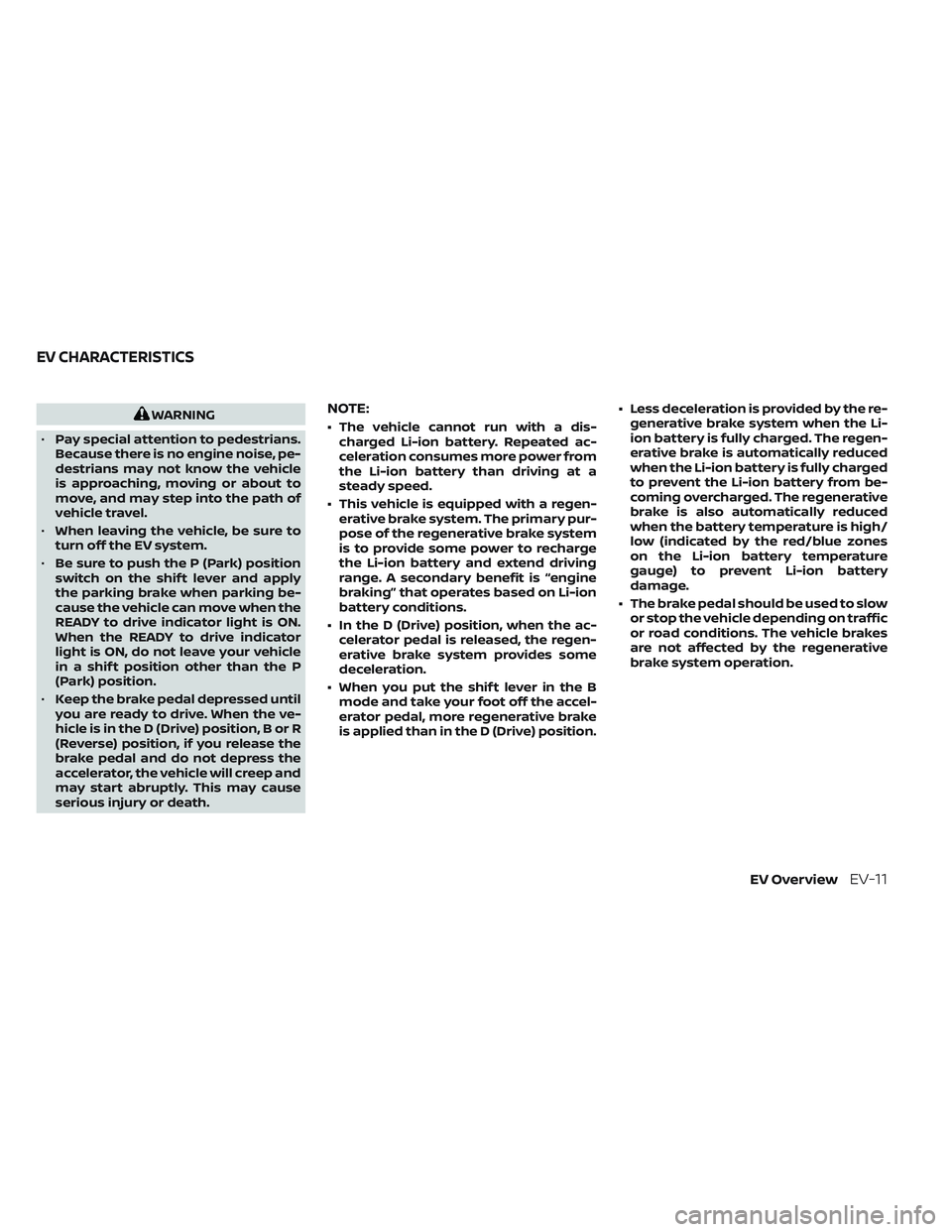
WARNING
• Pay special attention to pedestrians.
Because there is no engine noise, pe-
destrians may not know the vehicle
is approaching, moving or about to
move, and may step into the path of
vehicle travel.
• When leaving the vehicle, be sure to
turn off the EV system.
• Be sure to push the P (Park) position
switch on the shif t lever and apply
the parking brake when parking be-
cause the vehicle can move when the
READY to drive indicator light is ON.
When the READY to drive indicator
light is ON, do not leave your vehicle
in a shif t position other than the P
(Park) position.
• Keep the brake pedal depressed until
you are ready to drive. When the ve-
hicle is in the D (Drive) position, B or R
(Reverse) position, if you release the
brake pedal and do not depress the
accelerator, the vehicle will creep and
may start abruptly. This may cause
serious injury or death.NOTE:
• The vehicle cannot run with a dis- charged Li-ion battery. Repeated ac-
celeration consumes more power from
the Li-ion battery than driving at a
steady speed.
• This vehicle is equipped with a regen- erative brake system. The primary pur-
pose of the regenerative brake system
is to provide some power to recharge
the Li-ion battery and extend driving
range. A secondary benefit is “engine
braking” that operates based on Li-ion
battery conditions.
• In the D (Drive) position, when the ac- celerator pedal is released, the regen-
erative brake system provides some
deceleration.
• When you put the shif t lever in the B mode and take your foot off the accel-
erator pedal, more regenerative brake
is applied than in the D (Drive) position. • Less deceleration is provided by the re-
generative brake system when the Li-
ion battery is fully charged. The regen-
erative brake is automatically reduced
when the Li-ion battery is fully charged
to prevent the Li-ion battery from be-
coming overcharged. The regenerative
brake is also automatically reduced
when the battery temperature is high/
low (indicated by the red/blue zones
on the Li-ion battery temperature
gauge) to prevent Li-ion battery
damage.
• The brake pedal should be used to slow or stop the vehicle depending on traffic
or road conditions. The vehicle brakes
are not affected by the regenerative
brake system operation.
EV CHARACTERISTICS
EV OverviewEV-11
Page 35 of 612
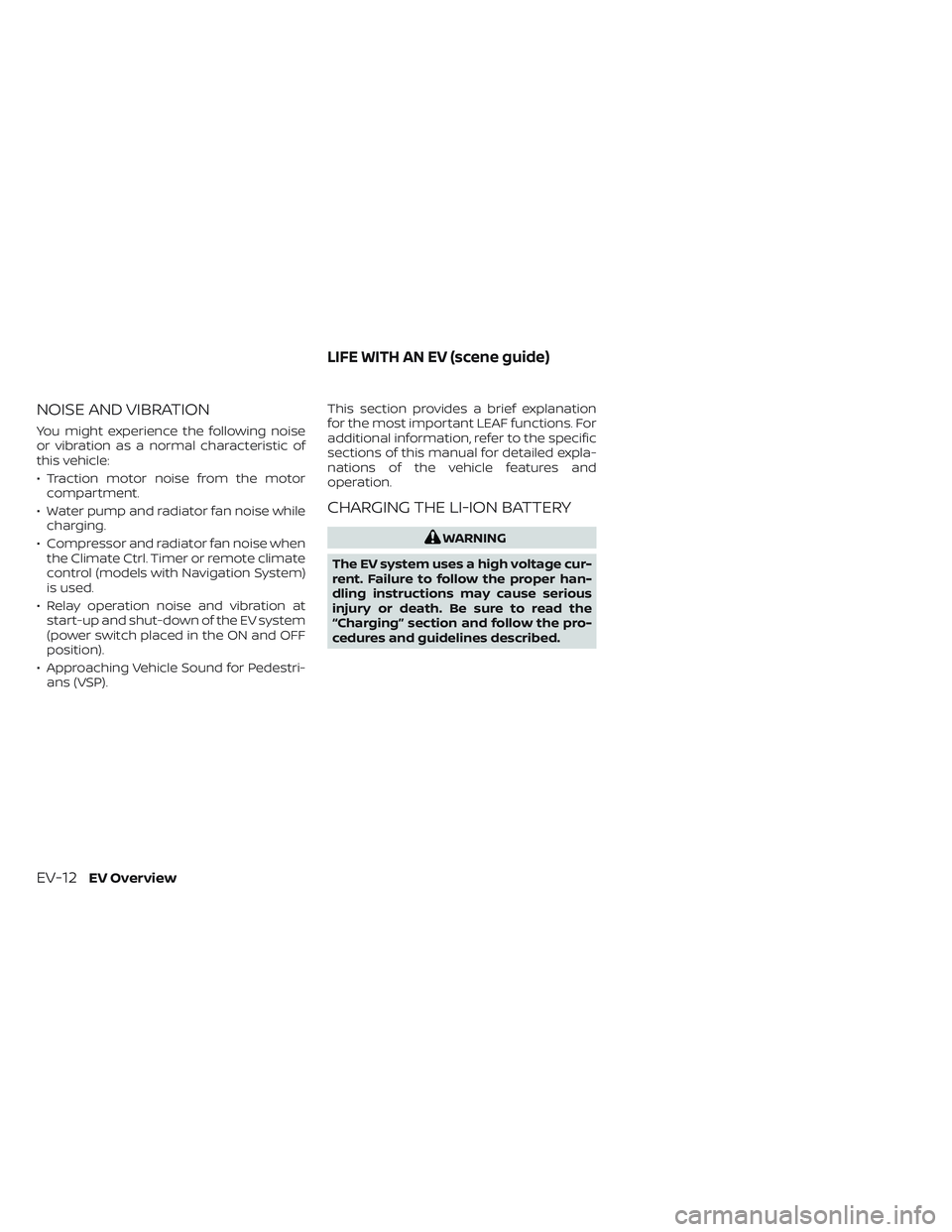
NOISE AND VIBRATION
You might experience the following noise
or vibration as a normal characteristic of
this vehicle:
• Traction motor noise from the motorcompartment.
• Water pump and radiator fan noise while charging.
• Compressor and radiator fan noise when the Climate Ctrl. Timer or remote climate
control (models with Navigation System)
is used.
• Relay operation noise and vibration at start-up and shut-down of the EV system
(power switch placed in the ON and OFF
position).
• Approaching Vehicle Sound for Pedestri- ans (VSP). This section provides a brief explanation
for the most important LEAF functions. For
additional information, refer to the specific
sections of this manual for detailed expla-
nations of the vehicle features and
operation.
CHARGING THE LI-ION BATTERY
WARNING
The EV system uses a high voltage cur-
rent. Failure to follow the proper han-
dling instructions may cause serious
injury or death. Be sure to read the
“Charging” section and follow the pro-
cedures and guidelines described.
LIFE WITH AN EV (scene guide)
EV-12EV Overview
Page 36 of 612
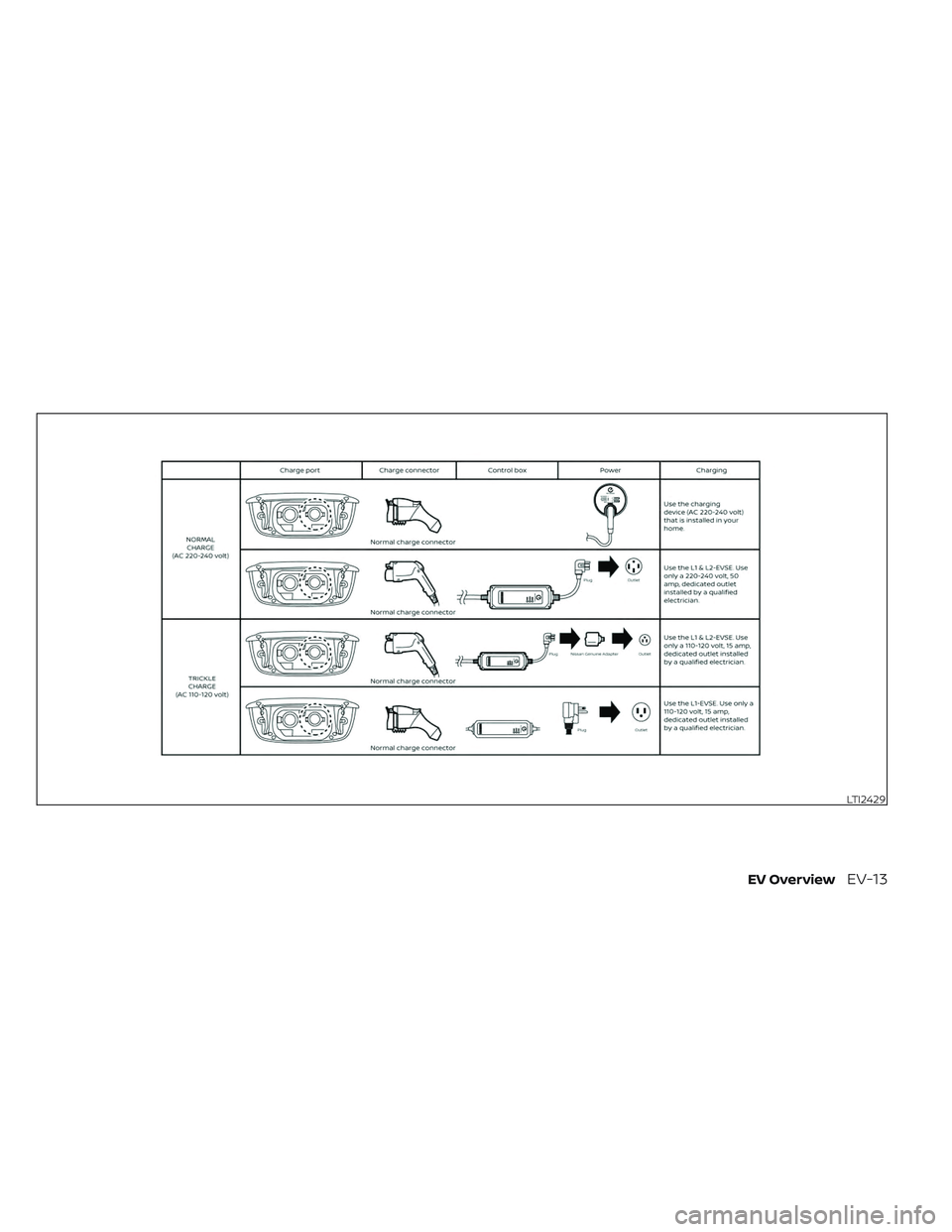
LTI2429
EV OverviewEV-13
Page 37 of 612
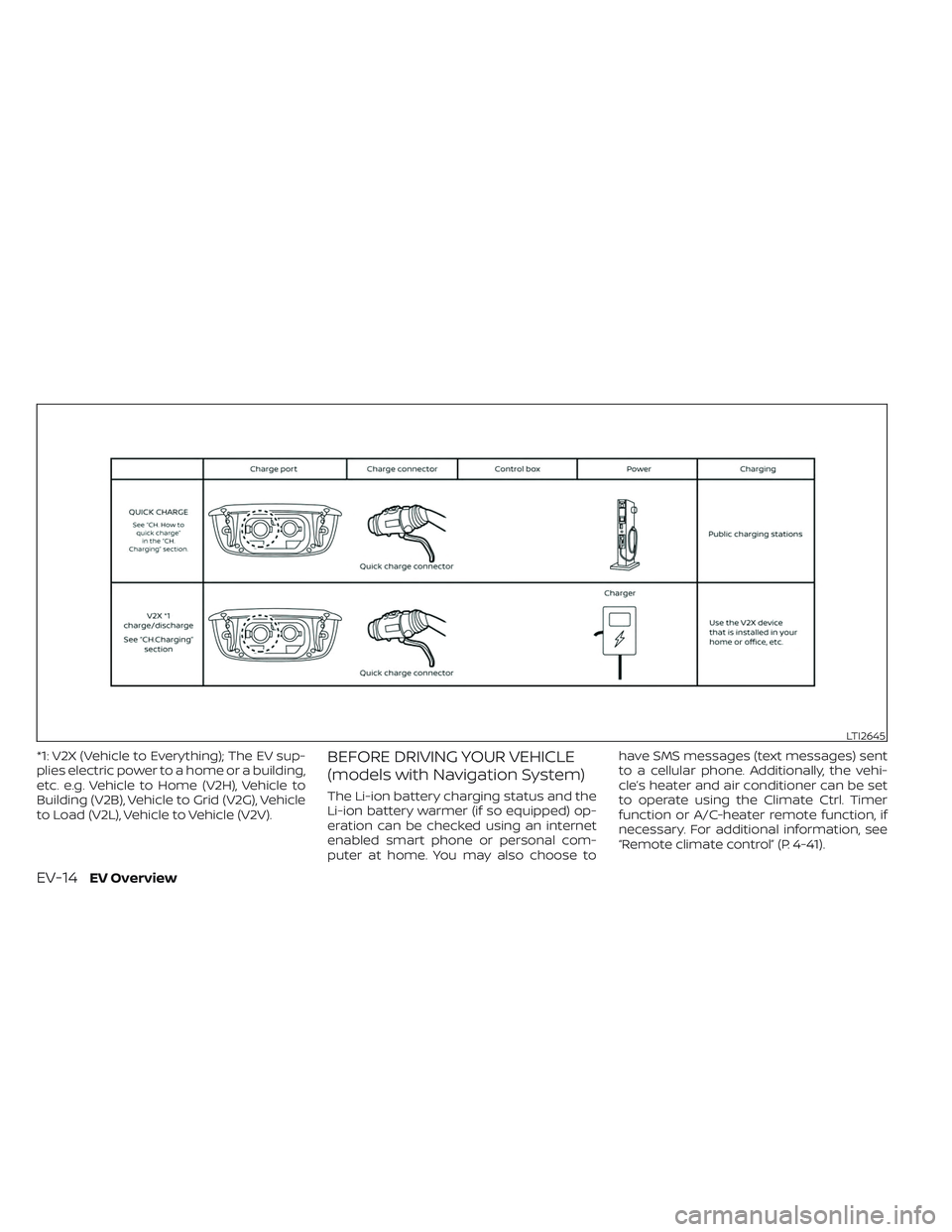
*1: V2X (Vehicle to Everything); The EV sup-
plies electric power to a home or a building,
etc. e.g. Vehicle to Home (V2H), Vehicle to
Building (V2B), Vehicle to Grid (V2G), Vehicle
to Load (V2L), Vehicle to Vehicle (V2V).BEFORE DRIVING YOUR VEHICLE
(models with Navigation System)
The Li-ion battery charging status and the
Li-ion battery warmer (if so equipped) op-
eration can be checked using an internet
enabled smart phone or personal com-
puter at home. You may also choose tohave SMS messages (text messages) sent
to a cellular phone. Additionally, the vehi-
cle’s heater and air conditioner can be set
to operate using the Climate Ctrl. Timer
function or A/C-heater remote function, if
necessary. For additional information, see
“Remote climate control” (P. 4-41).
LTI2645
EV-14EV Overview
Page 38 of 612
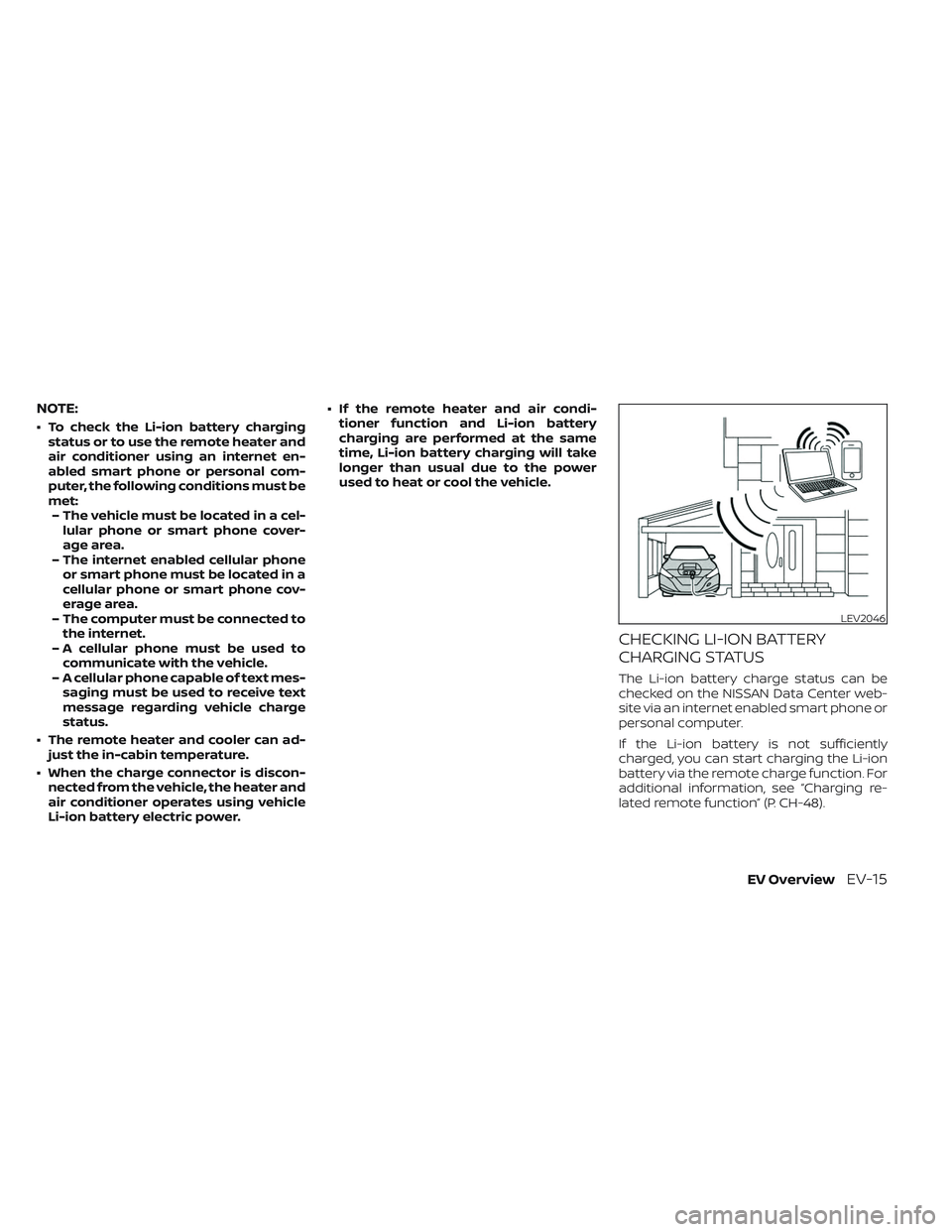
NOTE:
• To check the Li-ion battery chargingstatus or to use the remote heater and
air conditioner using an internet en-
abled smart phone or personal com-
puter, the following conditions must be
met:– The vehicle must be located in a cel- lular phone or smart phone cover-
age area.
– The internet enabled cellular phone or smart phone must be located in a
cellular phone or smart phone cov-
erage area.
– The computer must be connected to the internet.
– A cellular phone must be used to communicate with the vehicle.
– A cellular phone capable of text mes- saging must be used to receive text
message regarding vehicle charge
status.
• The remote heater and cooler can ad- just the in-cabin temperature.
• When the charge connector is discon- nected from the vehicle, the heater and
air conditioner operates using vehicle
Li-ion battery electric power. • If the remote heater and air condi-
tioner function and Li-ion battery
charging are performed at the same
time, Li-ion battery charging will take
longer than usual due to the power
used to heat or cool the vehicle.
CHECKING LI-ION BATTERY
CHARGING STATUS
The Li-ion battery charge status can be
checked on the NISSAN Data Center web-
site via an internet enabled smart phone or
personal computer.
If the Li-ion battery is not sufficiently
charged, you can start charging the Li-ion
battery via the remote charge function. For
additional information, see “Charging re-
lated remote function” (P. CH-48).
LEV2046
EV OverviewEV-15
Page 39 of 612
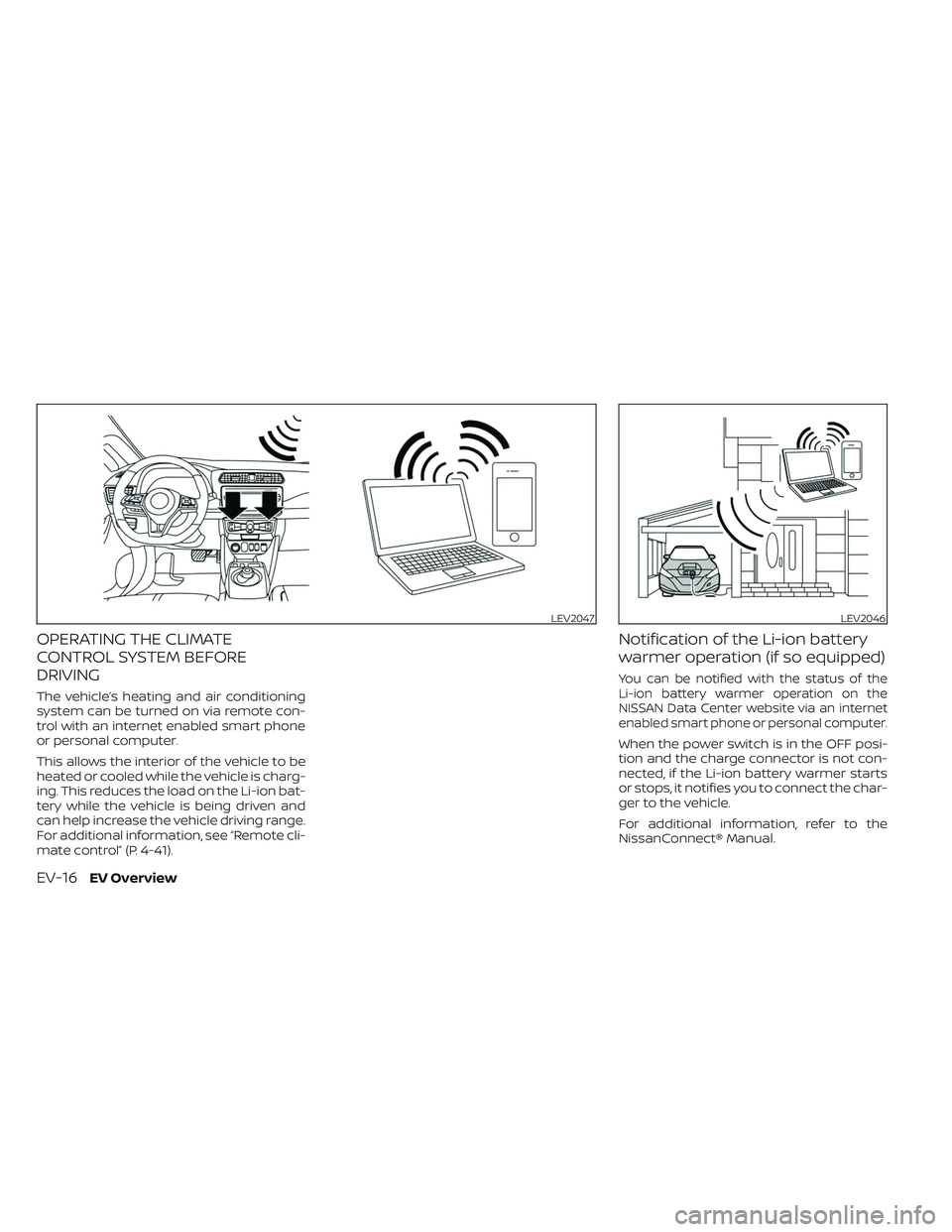
OPERATING THE CLIMATE
CONTROL SYSTEM BEFORE
DRIVING
The vehicle’s heating and air conditioning
system can be turned on via remote con-
trol with an internet enabled smart phone
or personal computer.
This allows the interior of the vehicle to be
heated or cooled while the vehicle is charg-
ing. This reduces the load on the Li-ion bat-
tery while the vehicle is being driven and
can help increase the vehicle driving range.
For additional information, see “Remote cli-
mate control” (P. 4-41).
Notification of the Li-ion battery
warmer operation (if so equipped)
You can be notified with the status of the
Li-ion battery warmer operation on the
NISSAN Data Center website via an internet
enabled smart phone or personal computer.
When the power switch is in the OFF posi-
tion and the charge connector is not con-
nected, if the Li-ion battery warmer starts
or stops, it notifies you to connect the char-
ger to the vehicle.
For additional information, refer to the
NissanConnect® Manual.
LEV2047LEV2046
EV-16EV Overview
Page 40 of 612
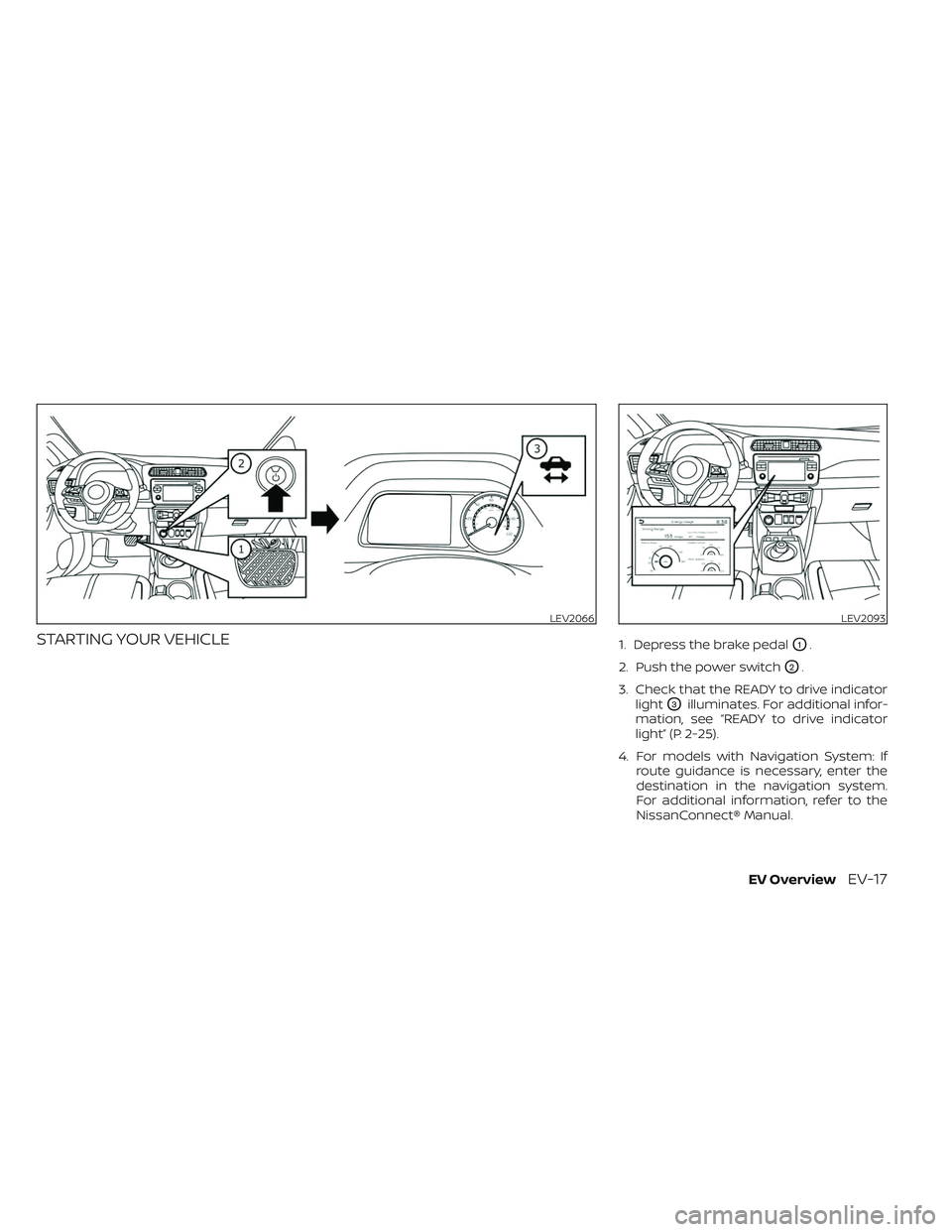
STARTING YOUR VEHICLE1. Depress the brake pedalO1.
2. Push the power switch
O2.
3. Check that the READY to drive indicator light
O3illuminates. For additional infor-
mation, see “READY to drive indicator
light” (P. 2-25).
4. For models with Navigation System: If route guidance is necessary, enter the
destination in the navigation system.
For additional information, refer to the
NissanConnect® Manual.
LEV2066LEV2093
EV OverviewEV-17